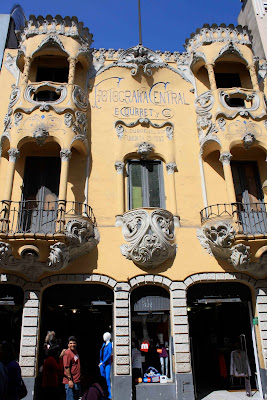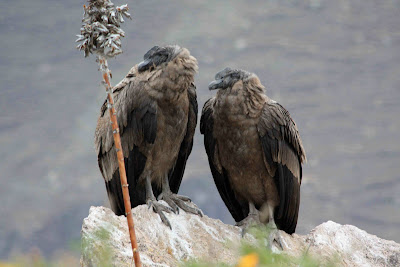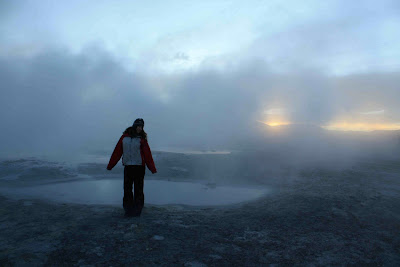I felt a sense of sadness upon arriving in Lima, the capital of Peru. This would be the final Latin American stop of our trip. Eight months of travelling had almost come to an end. The flights home had been booked months ago, but only now was the realisation starting to sink in.
However, it was as if Lima had realised my sadness and decided to cheer me up a little. Our hotel, based on the outskirts of Miraflores, didn't have a great deal going for it but it was opposite one of the stations of a new bus route straight into the centre of Lima, called the Metropolitana. And in no hurry to recoup any costs, they hadn't even started charging people to use it yet. So we hopped on. How very kind of them.
While Miraflores is the up-market, clean and trendy part of Lima, where you will find all the western goodies, the best hotels and theatres, you shouldn't pass up on an opportunity to see the historic centre. It has the upper hand on architecture with the main Plaza del Armas particularly vast and stunning. We walked through it and took a moment to consult our map. Within seconds, two members of Lima's Tourist Police came over to see if we needed any help. They spoke English, provided us with some sightseeing tips and warned us to watch out for any would-be criminals lurking about. It is one of the most striking things about my experiences travelling in this part of the world. They value their tourists very highly. Perhaps our trip has coincided with an increase in prosperity or a new effort to stamp out crime in city centers. Whichever, it certainly makes you feel a little more comfortable to roam the streets.
We had earmarked Lima as the place to do some last-minute market shopping to pick up some gifts. It was by no means an easy task. The bulk of the shopping had been done in Arequipa, where I had had the same feeling when looking around stalls and shops; would anyone actually appreciate this stuff? There are a certain type of folk who love nick-naks and ornaments and, well, anything as long as it has come from a far and distant land. I do not know many of these people. My family, much like I, do not have a fondness for Inca figurines or miniature llamas to collect dust on the mantelpiece. So, it had to be items of clothing instead. And warm items at that. Everything is made from thick and soft materials like Alpaca. So. they would have to serve as presents for the upcoming British winter in, erm, six months time!
We did take a break from the trauma of market shopping to visit the San Francisco Convent and its catacombs. Here a guide took us around the church, showed us the paintings and then guided us through the underground vaults that contain skulls and bones from as many as 70,000 people. Creepy, but amazing. The second part of the tour enabled us to see the famous library. Standing at one end of the room you can see hundreds of books dating back hundreds of years. A bit odd, but they had roof-lights letting in loads of air and natural light. Apparently stable environmental conditions are not needed to keep the books from crumbling away.
Back in Miraflores for the evening, we indulged in some heavy eating at a North American-style bar and grill which left us barely capable of walking. The area down by the sea-front is a large complex built into the side of the cliffs, and is a perfect place to watch the sunset over a cocktail - or a huge steak in our case! It is a slice of modern living that I suspect only the top end of society in Peru could afford, and it seems a million miles away from the mountain villages we visited just weeks before. But nonetheless it made for a fantastic final evening on the South American continent.
Owing to what I can only assume is past experience, the general consensus is that tourists should take a cab to the airport. Not only that, but a recognised and registered one. And if you do just pick one from the street, memorise its number in case you get into bother. The trouble is that a cab to the airport costs about $25 to $30 USD, and it's really not all that far. Our hotel wanted about $40USD to shuttle us there. No, we'd rather run the gauntlet instead. What's wrong with little drama to end the travels anyway?
You can get to the airport for far less by taking a collectivo (minivan/bus thing) that follows a certain route and gets you to within a few blocks. So this is what we did. Bright and early on a Sunday morning we waited on a street corner with our back-packs until the right numbered van came along. It would cost all of about a dollar between us doing it this way. I had a rough idea of which direction the airport was in, but not long after making a left turn here and right turn there, I had no idea where we were. The van continued to drop off people and pick-up new ones as we headed out of one district and into another. It wasn't long before I started to play out nasty scenarios in my head. For each person we picked up I made a two second character evaluation in my head. Was this going to be the guy who would hold up the van and make off with everything we own? What would I do in such a scenario? I couldn't get mugged on the very last morning now could I? My only comforting thought was that it was Sunday morning and I'm quite sure that criminals like a lie-in!
An hour passed and we were still none the wiser about when we would reach our destination. Things would be a bit touch and go if we didn't get there soon. Suddenly the van stopped at a junction and we were told this was our stop. We got out and learned that the airport was left and about four blocks on. Seeing that we were about to undertake this journey on foot, a local man stepped in and offered that we share a taxi with him, as he was going that way. I made a snap judgement that this guy was in fact friendly and genuinely concerned for our well-being. Eight months travelling sharpens the senses but I made sure I had the penknife to hand. Not a clever strategy to fall back on, I know!
We took a cab with him and found that the four blocks were very long and very, well, dodgy. The local man had feared for our safety and rightly so. The taxi driver charged us a little too much for this five minute journey, but we had made it to the airport in one piece and with all our belongings, toy llamas and all!
Country Notes and Tales From Travellers
13 years ago




















































